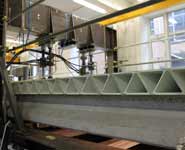Composites are stiff, strong, light, corrosion-resistant materials that have been successfully used in the aerospace and automotive industries for decades. They behave differently from traditional constructions materials such as steel, concrete and timber, so fresh strategies are needed to find ways of using composites in cost-effective civil engineering applications.
New research led by Dr Wendel Sebastian, Senior Lecturer in Structural Engineering in the Department of Civil Engineering at Bristol University, is looking at the use of advanced composite decks for traffic bridges.
Bridges using advanced composites for the deck and/or the main beams have been built in the USA, UK and Spain. However, despite its obvious advantages, this novel bridge technology is not yet normal practice within modern bridge engineering. A key issue is that very little research has been carried out examining the weathering of the composite materials and how they react to the loads bridges have to carry, especially where fatigue performance is concerned.
The research team have constructed and are testing a prototype of a large-scale bridge with composite decking at the University’s structures laboratory. The model, which is eight metres long and 3.7 metres wide, comprises ASSET composite decking spanning across pre-tensioned concrete (PTC) main beams.
The PTC beams match the corrosion resistance of the decking and also improve stiffness. One innovation is that only adhesive connections have been used between deck units and to connect the deck to the main beams, which simplifies and speeds up construction.
The prototype will be subjected to over 100 million cycles of full-scale, code-specified fatigue wheel loading. The large plan area of deck will investigate the effects on deck performance of different anti-skid surfacings. Finally, the model will be loaded to failure. The results from the testing and from advanced computer models of the test specimen will underpin design guidelines for short- and long-term actions of this innovative bridge form.
Dr Sebastian said: “Due to their low weights, high stiffness and high strength, advanced composites are leading to a new generation of lighter and more fuel-efficient aircraft such as Airbus’ A350, and also Boeing’s 787 Dreamliner which is heading towards 20 per cent better fuel efficiency than traditional aircraft.
“We would like to achieve an equivalent transformation in Civil Engineering, with advanced composites underpinning step changes in the economics, sustainability and structural performance of road bridges.”
The project is supported by the Highways Agency, the Institution of Civil Engineers, Network Rail, Mouchel, Tarmac and Weber.
